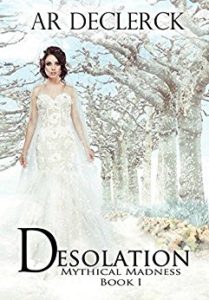 The books: The Collector series by Dot Hutchison
The books: The Collector series by Dot Hutchison
The music: “My Muse” by Red Sun Rising
(Okay, so disclaimer: there might actually by a book equivalent of CSI: SVU.)
Last week, blogger and fellow author Corinne Morier reviewed The Butterfly Garden on her blog. I was home with the flu and couldn’t get out of bed, so I bought it on Amazon (just $1.99) and read it. And then Amazon told me it was a series, so I bought and read the next two as well.
The first book, The Butterfly Garden, tells the story of Maya, a teenage girl kidnapped by a sadistic man known only as the Gardener. He collects girls, tattoos butterfly wings on their backs, and forces them to live as part of his harem in his backyard botanical garden, until they turn 21 and he kills them, preserving their bodies in resin. The story alternates between an FBI agent, Vic, listening to Maya tell her story, and the story itself. Although the premise is beyond horrific, the abuse isn’t very graphic, and the book instead focuses on what makes Maya such a survivor.
The second book, The Roses of May, switches from Agent Vic and Maya to Agent Edderson, his partner, who’s working another serial killer case. This time, someone is killing a girl every spring and leaving her body in a church. He suspects that this time the victim will be Priya, a teenage girl whose sister was murdered by the serial killer five years ago. Again, the book isn’t so much about the horrific details, as it is Priya’s story about surviving trauma.
The third book, The Summer Children, again switches from Agent Edderson to his partner, Agent Ramirez. Someone is killing abusive parents and leaving the unharmed children on Ramirez’s porch. Throughout this book, the focus is again on overcoming trauma – in this case, Ramirez’s recollections of her own childhood abuse.
I can’t speak to the accuracy of the FBI agents’ methods in each case; I get most of my criminal investigation knowledge from the crime dramas I watch with my dad. But I can comment on the response to the trauma that Maya, Priya, and Ramirez endured, and it’s pretty accurate.
First, the Butterflies as a whole. More than a few people remarked in their reviews that, “If I were in their situation, I would just escape. Twenty-two girls against one man – how hard could it be?” But most people, when thinking about a threat, inaccurately think of just two responses: fight or flight. Either the girls gang up on the Gardener (fight) or they run away as soon as they have the chance (flight). There’s actually a third response, which is the most common response when people encounter trauma, especially when it’s ongoing: freeze. Think of it as learned helplessness, and not necessarily learned directly. This guy has been taking girls for twenty-plus years, and all their bodies are on display. The Butterflies know that if they try to fight back, there’s a good chance they’ll be killed. Die immediately, or die eventually? So, they freeze.
(Relatedly, many women freeze when sexually assaulted. Their assailants, and a lot of the community as a whole, take this for consent since they don’t try to fight back or escape. This leads to horrible victim-blaming, especially of the women towards themselves.)
But what happens when you’ve escaped or been rescued or otherwise survived? That brings us to the themes explored in books 2 and 3, which include survivor’s guilt. Everyone expresses it differently: Priya binges, her mom is a workaholic, her dad kills himself, and Ramirez becomes an agent investigating the types of crimes that were once committed against her. Is any method more effective than another (except suicide, obviously)? Sometimes it changes from day to day, experience to experience.
Overall, I highly recommend this series. They’re each only $1.99, so really, there’s no reason not to check them out.
The song is one of my favorites by Red Sun Rising. Maybe it’s about relationships, but I think in a broader sense it’s about not moving on from a bad situation, even though you know you should, and how the people we surround ourselves with can make it easier or harder to move on.
If you’ve read these books, please share your thoughts. And share your thoughts on the song as well!

 The books:
The books:  The book:
The book:  The books:
The books: 



